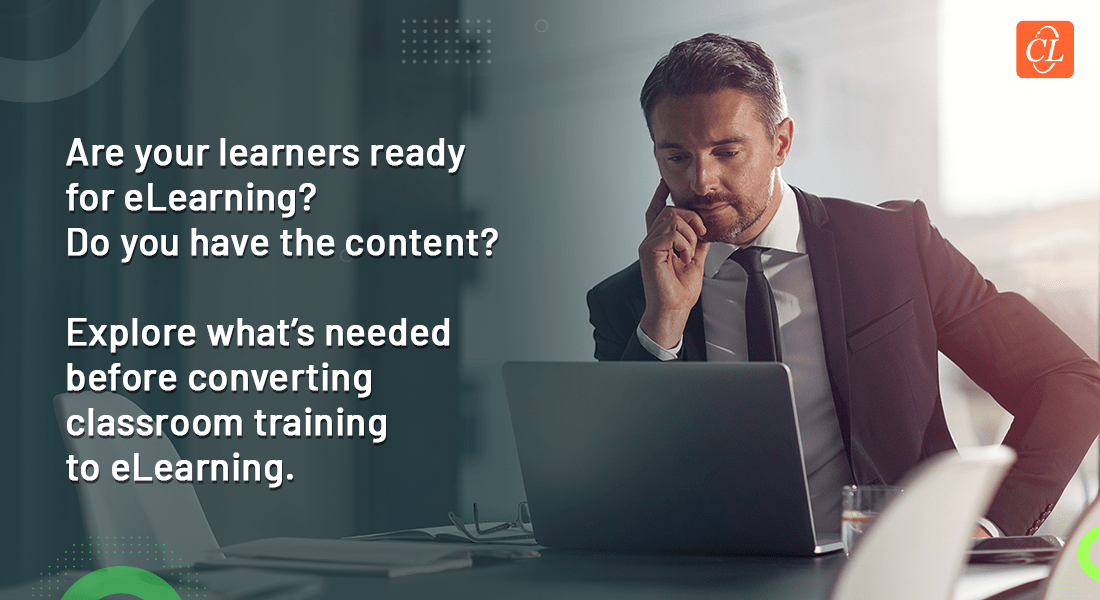Leveraging your Existing ILT Materials for eLearning

Organizations don’t adopt eLearning in a vacuum. Most of them already have well-established Instructor Led Training (ILT) programs in place to address their organization-wide training needs thus far. And most of this is supported by instructionally sound training material. All they have to sometimes do is convert this existing ILT material into eLearning after suitable tweaking and treatment as required. However, there are two common mistakes organizations routinely make when planning an eLearning implementation – sometimes they tend to overlook what they already have and try to reinvent the wheel by developing content from scratch or they swing to the other extreme and assume that just because they have all the content they need, they don’t need that much effort to convert it to eLearning. As a result, they end up not factoring enough time, cost and resources required to define, design, develop, and deploy effective learning programs.
If you already have an extensive training program and the infrastructure, content and the presence of instructors, tutors and subject matter experts to support it, ensure that you tap these rich resources. Once you identify your existing resources, identify content that is best suited to eLearning. Here are a few things you need to evaluate before you even start creating or tweaking content.
What content do you want to deliver through eLearning? Is the material that you have instructionally sound (are there suitable learning objectives, does the flow of content support easy retention, is the content arranged in a logical sequence, are there sound assessments in place etc.)? If existing materials are well-developed, then you need to only focus on how best you can now present them in an eLearning format with the suitable use of interactive instructional design, media strategies, and engaging functionality. What is the best instructional approach for the various types of content? How will you plan for the treatment of different content types? Do you want to use exploratory approaches, simulations etc.? Ensure that you make all eLearning content relevant by building in lots of scenarios, examples, and case studies. This will help learners learn and retain learning.
What type of e-learning process do you want to use? Traditional or rapid eLearning? The answer to this question will determine the types of tools that you will need to invest in.
These decisions need to be taken at the planning stage because your eLearning budget will be affected by your decisions. Conventional e-learning takes longer, has a longer development process, uses different sets of tools and requires a different set of skills for course development. Because it takes longer time and requires specialized skill-sets, it is more expensive than rapid eLearning. However, if you go in for rapid eLearning by developing courses internally rather than outsourcing it to custom content development companies, then you will have considerable initial expenses in acquiring the required tools and training people to use them. However, the main advantage of rapid development is the fact that once these skills are acquired, your team can develop courses quickly – a critical advantage for supporting the business goal of faster-speed-to market. With the plethora of rapid eLearning tools available in the market, it pays to invest in some of them even if you are planning to take the longer and more traditional route towards eLearning.
Once you keep some of these considerations in mind, it becomes easier to plan for converting existing ILT materials to eLearning programs.



![What’s Your eLearning Readiness? Drive Adoption with these Best Practices [Webinar]](https://blog.commlabindia.com/hubfs/Imported_Blog_Media/eLearning-readiness-adoption-best-practices-webinar.jpg)
![Converting ILT to eLearning: The Ultimate Time-tested Process [Infographic]](https://blog.commlabindia.com/hubfs/Imported_Blog_Media/E-learning-Development-Process-3.jpg)
